At Aero Friedrichshafen 2023, visitors saw numerous aircraft that could qualify as Mosaic Light-Sport Aircraft or mLSA. In nearly every aisle of the several large halls of Aero, visitors and journalists could see entry after entry apparently made-for-Mosaic. Indeed, so many entries potentially qualify for this coming new segment that I ran out of time to examine all of them.
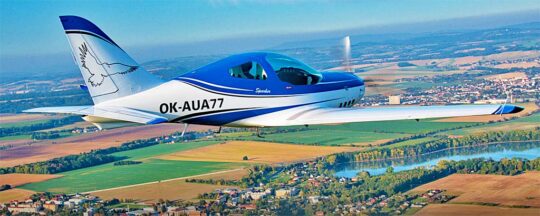 We are headed into an interesting period of aircraft development and the subject of this article is a perfect example. Welcome to TL Ultralight’s enhanced Sparker.
We are headed into an interesting period of aircraft development and the subject of this article is a perfect example. Welcome to TL Ultralight’s enhanced Sparker.
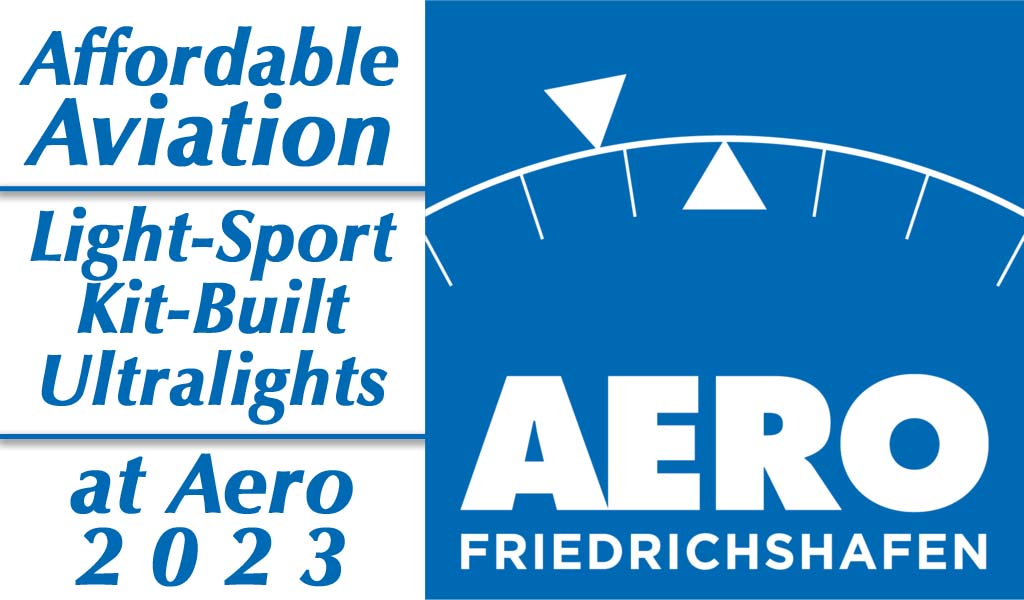 The model was introduced to the European 600 kilogram (1,320 pound) standard but over the last year it has gone through an extensive evaluation and upgrade to carry a 750 kilogram load (1,653 pounds). It was also revised to accommodate Rotax’s 915iS and 916iS engines.
The model was introduced to the European 600 kilogram (1,320 pound) standard but over the last year it has gone through an extensive evaluation and upgrade to carry a 750 kilogram load (1,653 pounds). It was also revised to accommodate Rotax’s 915iS and 916iS engines.
With greater capacity and with 160 horsepower available, I’d call this a mLSA or Mosaic-ready Light-Sport Aircraft.
Sparker = mLSA
You already know Czech producer TL Ultralight. The European company dates to 1989 as the Berlin Wall fell. By 1991, TL-Ultralight began series production of a two-seat light aircraft that vaguely resembled a Rans S-6. TL 32 Typhoon was the first airplane to carry the TL trademark. By 1996 TL 96 Star was born as an all-composite low-wing monoplane.

TL Sport Aircraft’s line includes Sting (L) and Sirius (C) plus the Stream.
Sting arrived in North America as an LSA after the Sport Pilot/Light-Sport Aircraft rule was released in 2004. In a field that recently hit 158 models accepted by FAA, Sting was the #5 Special LSA to win approval. Sing S3/S4 was reapproved as #71 on my SLSA List and the high wing Sirius won approval at #103. Add several European approvals to see TL Ultralight is experienced in earning approval for their latest aircraft, Sparker.
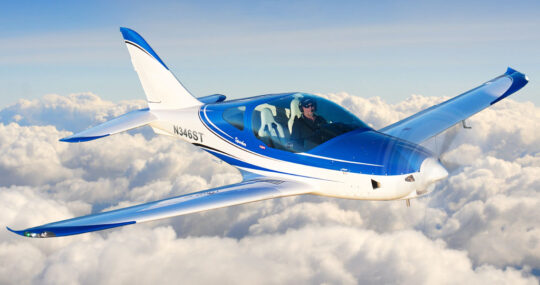
“Sparker is more than just an aircraft recertified to a higher take off weight,” reported Trey. The new entry is spacious and makes good use of the space and weight capacities. Additional take-off weight allows for a large luggage area that can hold 55 pounds in a space large enough for two sets of golf clubs. A smaller area up front can handle lightweight items you need in flight. Besides the additional load, you’ll be able to access the compartment through an exterior door, eliminating one annoying aspect of loading some low-wing aircraft, requiring that you kneel on the seats and sling bags over a bulkhead.
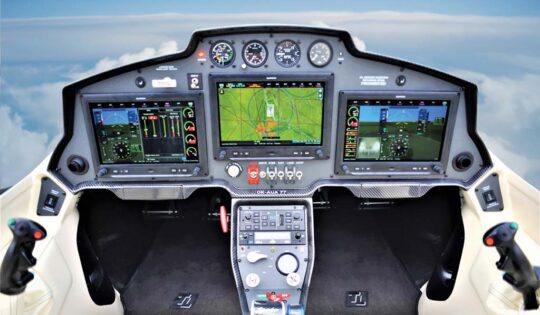
Sparker is fitted with three 10-inch Garmin G3X displays, Garmin GMC 507 autopilot, Garmin 245R ADSB in and out, Garmin radios, and an option for IFR flight with the Garmin GTN 650 avionics package. Dual side joysticks have various button controls.
Sparker’s fuselage is formed over a Kevlar shell, providing excellent protection for the crew compartment. TL engineered both Stream and Sparker to have crumple zones similar to modern autos to dissipate loads before they reach occupants.
Sparker is high end throughout. TL fitted luxury heated leather seats and in-cabin heat. Electric adjustable pedals make it easy to find the perfect fit.
What to Expect
in mLSA Prices
You surely realize that with a 175-knot cruise speed, a 160-horsepower modern computer-controlled engine, not one or two but three large Garmin G3X instruments, a Stratos emergency airframe parachute, and a luxurious interior — all this will not come cheap. Here’s another sure to exceed the $300,000 mark.
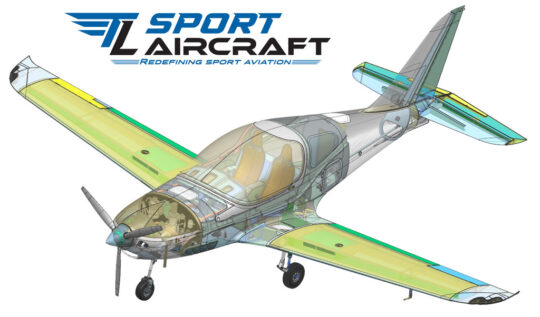
Perhaps the best news about Mosaic is that it will not negatively impact the LSA you have come to know and love. Many of those airplanes remain available at much more affordable prices. In addition, a growing number of used LSA are now available at even lower cost.
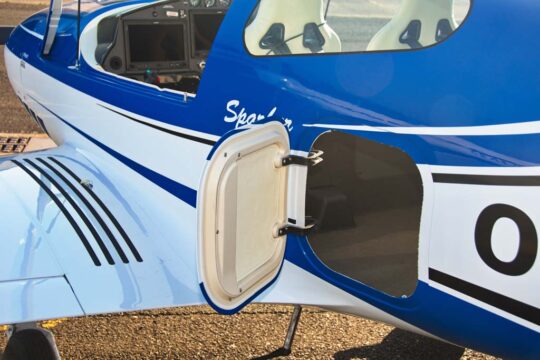
“The first Sparkers will come in under the Experimental Exhibition category,” said Trey. He and TL personnel will investigate mLSA approval after Mosaic is out.
Come EAA AirVenture Oshkosh 2023 in just a few weeks, we may find out if FAA’s promise will be kept. Last year the Mosaic Notice of Proposed Rule Making (NPRM) was predicted by “August 2023.”
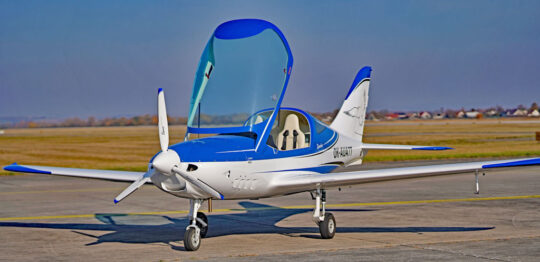
TECHNICAL SPECIFICATIONS
TL Ultralight Sparker
all specifications provided by the factory
- Length — 21.75 feet
- Height — 8.4 feet
- Wing Span — 29.5 feet
- Wing Area — 107 square feet
- Horizontal Tail Width — 9.7 feet
- Cabin Width — 49.2 inches
- Empty Weight (depending on options)* — 772 pounds
- Maximum Takeoff Weight** — 1,320 pounds
- Maximum Crew Weight — 440 pounds
- Maximum Luggage Capacity — 55 pounds
- Luggage Compartment Volume — 24 cubic feet
- Never-Exceed Speed — 181 knots
- Typical Cruise — 165-175 knots, per U.S. representative***
- Minimum Speed — 45 knots
- Climb Rate (at gross weight)* — 1,200 feet per minute (2,000 fpm with 915iS)
- Fuel Consumption (75% power)* — 4.25 gallons per hour (7 gph with 915iS)
- Fuel Capacity — 24 to 34 gallons
- Range — 869 statute miles
- Engines**** — Rotax 912ULS, 915iS, and 916iS
- Propeller — three-blade PowerMax
- Landing Gear — Hydraulic retractable landing gear; trailing link main gear
* Factory figure based on Rotax 912 ULS; more powerful engines are available
** TL Ultralight has increased MTOW to 1,653 pounds (750 kilograms)
*** U.S. representative cruise speed based on Rotax 915iS
**** TurboTech turbine powerplant (160 horsepower) is in development
ARTICE LINKS:
- TL Ultralight, Czech factory website
- TL Sport Aircraft, U.S. importer website
- TL Ultralight aircraft, articles on this website
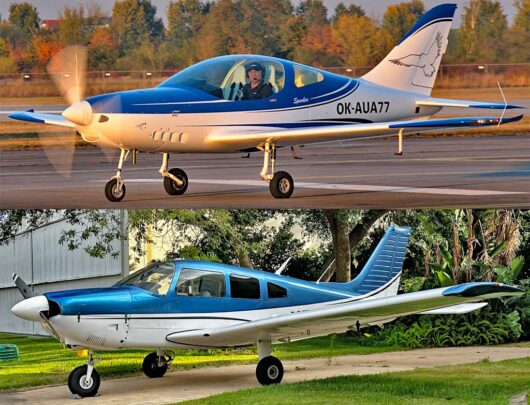
NEW & OLD — Sparker compared to a somewhat similar Piper legacy model. While the Piper has four seats, Sparker is retractable and much faster.


Dan
I have misplaced the article you wrote about joining the Flying Magazine group. Does this mean you will no longer be doing these LSA articles on this website?
I also have a question regarding controls. Most of the LSA aircraft I see have joysticks rather than yoke wheels. I learned to fly in a Taylorcraft BC12D and all my flights have been in non-stick aircraft except for 2 hrs of aerobatic training in a Decathlon. Besides the Ercoupe which modern LSA aircraft are still using a wheel?
First, here’s a link to my announcement article. Technically, I did not “join” Flying Magazine group. I sold my website brand and content to them. However, since I did, you’ve noticed little difference and I trust it will largely remain that way (although change is inevitable). My participation will decline but not disappear.
Check out the Montaer. The just said the MC01 will fly at 1650 lbs when Mosaic lands. They use Yokes and it looks like it will be a great bird for XC at that weight.
By all means, check out Montaer. All content on this model available at the link.
What ever happened to ultralight and experimental flying that didn’t require FAA watch dodging? Where you could enjoy flying around the corn field for a couple of bucks an hour?
The FAA destroyed weekend flyers and the ultralight industry. You’re hard pressed to even find parts to keep your bird in the air.
Dan, what was flying the side stick like on this plane??
I did not fly Sparker, but I did fly Stream (also from TL), which also uses a side stick that is logically built in a very similar fashion. A side stick takes some acclimatization because you lose that centering instinct a joystick brings. Yet I would say in an hour or two you may be completely spoiled by the extra room a side stick affords.
So, it’s all going to be wonderful, next week. Just wait until next week and it’s all going to be wonderful.
I had a manager who used to say that all the time. I spent 37 years at that company. It never got wonderful.
I’ve been flying since 1965. It’s still not wonderful. The changes that have come are not for the benefit of the pilots, but for the convenience of the government and the benefit of the old iron manufacturers.
But, as they say, Hope springs eternal.
Forgive me. The weather has been crap and I haven’t flown my 1930’s technology airplane in a week, I’m grumpy.
…I’m still laughing! 😂
My bet is it will help the manufacturers of current LSA models, but most likely place excessive burdens on the sport pilot to obtain the sign off. But like Glenn says, “Hope springs eternal…”
Those 1930s technology aircraft are almost as fast as the current LSAs. And have a stall speed within 5 knots of the current LSAs. Not much has been learned about aircraft in the last 90 years. And if you add in reliability, those Cessnas and Pipers have the LSAs beat at least 2 to 1. Your whining is not backed up by the facts. Plus, the cost of used Cessnas and Pipers is a small fraction of the cost of new LSAs. One can not go wrong with a used single engine Cessna or Piper that has been maintained. Every A&P AI knows them inside an out and every airworthiness directive ever written on them. If you want safety and reliability at an affordable price; nothing in the aircraft market comes close to used single engines Cessnas or Pipers. I looked up the service bulletins on Van”s aircraft. It is at least as long as the ADs on Cessnas & Pipers. Meaning better and more reliable aircraft have not yet been built. Wake up and do some real world comparisons. I have given you a start here. The sacrifice going to a used single engine Cessna or Piper is small compared to buying a new LSA; primarily due to the comprehensive maintenance process of type certificate aircraft. Used single engine Cessnas and Pipers that have been maintained, which is the majority of the used plane market; have no peers by any over all measurement.
So will a Light Sport Pilot be able to fly these “Light Sport” aircraft?
I suspect you meant to ask, “Is a Sport Pilot certificate holder allowed to fly a Mosaic LSA at higher weights, higher speeds, with retractable gear, with adjustable prop, and additional features?”
My answer in prior articles or comment replies has been that this is up to FAA Flight Standards people from whom we’ve heard little. My hope, however, is that they will use the endorsement process to allow Sport Pilot certificate holders to upgrade (or demonstrate) their skills by taking additional training and getting an instructor sign off. That has worked well for LSA and I hope they’ll continue to use this method.
Man! I hope Mosaic does not disappoint us Light-Sport pilots. I hope to be able to afford this plane if it falls under new LSA rules in 2025. Last year was very disappointing and with another interim administrator on their way into office, I can only hope we don’t get let down by these new rules or release date. Thanks for all your reporting on this segment of aviation.
With legacy plane prices the way they are it may not matter if the new mLSA hits 300k. Why buy a 50 year old plane with old tech and new avionics? For the same amount of money you can buy a plane it’ll hit at least 1600 pounds MTOW have FADEC, modern avionics, new air frame, new engine, new interior, new paint. The real question is whether or not the bottom will fall out of the market of old airplanes.
See above, previous comment. 50 year old planes fly within 5 knots of current LSAs and have a stall speed within 5 knots of new LSAs. Avionics are now all nearly portable. Meaning you can have them in your lap, or the seat next to you, or installed/replaced in the aircraft panel; or any combination. The quality control on homebuilt aircraft is all over the map. Old and maintained type certificated aircraft are the only way in this regard. The market on old airplanes in the last two years has surged to double of what it was. Meaning little chance of the market bottom falling out. And if it does, only those people who have bought in the last two years have lost value and only if they do not hold on to their legacy aircraft. A small amount of legacy aircraft are not maintained and end up in the bone yard. So the legacy aircraft market is only getting smaller. And the chance of the legacy aircraft market dropping is possible; but is not likely due to diminishing numbers of legacy type certificated aircraft.